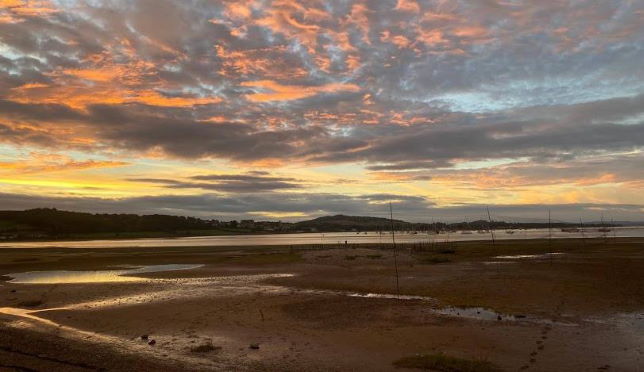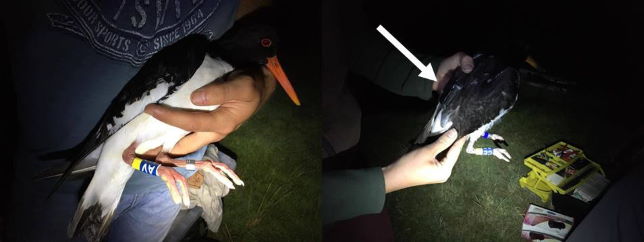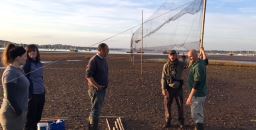Mist-netting - Exminster Marshes - Saturday 21st January 2023
High Tide 3.72m @ 18:26, Sunset 16:47
We carried out a mist-netting session at Exminster Marshes, catching and ringing 18 Dunlin, a Lapwing, a Teal and a Common Gull. The Dunlin were all colour-ringed as part of our ongoing project to study their use of the Exe Estuary and surrounding land. Full report to follow.
| Species | Ringed | Retraps | Controls | Colour ringed | GPS tagged |
|---|---|---|---|---|---|
| Dunlin | 18 | 0 | 0 | 18 | 0 |
| Lapwing | 1 | 0 | 0 | 0 | 0 |
| Teal | 1 | 0 | 0 | 0 | 0 |
| Common Gull | 1 | 0 | 0 | 0 | 0 |
Mist-netting - Exminster Marshes - Sunday 5th December 2021
High Tide 4.10m @ 19:23, Sunset 16:10, Rendezvous 14:45
The team gathered on a breezy Sunday afternoon at RSPB Exminster marshes to set a total of 13 mist nets in three separate lines, in preparation for an evening wader mist net catch. The site has a series of fields with newly established flooded pools that the waders come into when it is high tide out on the estuary, and it was across and around one of these pools the nets were set. As forecast, the wind died down during setting, and it was almost perfect conditions for the evening. All the nets were up with plenty of time to spare, and the team went back to the base to wait for dusk.
| Species | Ringed | Retraps | Controls | Colour ringed | GPS tagged |
|---|---|---|---|---|---|
| Oystercatcher | 1 | 0 | 0 | 0 | 0 |
| Lapwing | 2 | 0 | 0 | 0 | 0 |
| Curlew | 3 | 0 | 0 | 3 | 0 |
| Dunlin | 13 | 0 | 0 | 13 | 0 |
| Redshank | 10 | 0 | 0 | 0 | 0 |
| Black-tailed Godwit | 6 | 0 | 0 | 0 | 0 |
| Bar-tailed Godwit | 6 | 0 | 0 | 0 | 0 |
Mist netting - Dawlish Warren - Saturday 25 September 2021
High Tide 3.65m @ 21:56, Sunset 19:06
The main objective was to catch at up to 6 juvenile oystercatchers to enable the remaining 6 UHF GPS (which downloads data to a base station) tags to be deployed. Mist netting early in the autumn is the better as early in the season there are a good proportion of juveniles, but they tend to spend less time at the roost and more time feeding on fields as the season goes on. After being unable to muster a large enough team in August, we had a great response and assembled a team of 12 people for our first session of 2021. After collecting the group’s 18 foot long poles from the RSPB base from Exminster Marshes, Tim Frayling arrived on site to transfer kit from his car to Dave Scott’s truck. From 4.30pm the rest of the team started to assemble and despite problems with trying to find a petrol station with any fuel left, the Cornwall contingent arrived in good time and we walked down to the site via the Warren Golf club track. Fortunately, we had a large team that carried the poles down following Dave’s truck, which was carrying all the kit.
| Species | Ringed | Retraps | Controls | Colour ringed | GPS tagged |
|---|---|---|---|---|---|
| Oystercatcher | 12 | 0 | 0 | 11 | 11 |
Mist-netting - Dawlish Warren - Monday 7 September 2020
High Tide 3.50m @ 21:22, Sunset 19:44, Rendezvous 18:30
The Covid-19 pandemic has had and continues to have a significant impact on all our lives. It has affected our health and limited our ability to see friends and family, travel and conduct work as normal. Throughout the pandemic, there has been a constant review of ringing activities by the BTO. The DCWRG committee has kept the guidance under discussion with the aim to enable 2020-21 fieldwork within the rules and in a way which minimises risks to our members, stakeholders and collaborators. In late August, after the compilation of current guidance, a review of procedures adopted by other ringing groups and completion of a thorough risk assessment by the DCWRG committee; it was decided that mist-netting sessions could be appropriately held whilst following a Covid-19 protocol and on the approval of our site landowners. Shortly before our first scheduled mist-netting session, we received the approval of our Covid-19 risk assessment and working protocol from both Devon Wildlife Trust and Teignbridge Council enabling the first session to go ahead. Unfortunately, due to only having a few days to organise it and the need for experienced people under the CV-19 protocol, we had to be selective at who was asked to attend this first session. A team of 6 met at Dawlish at 1830 on the 7th September with the overall objective of catching juvenile Oystercatchers to deploy our remaining 9 GPS-UHF tags as part of the ongoing Exe Oystercatcher Study.
 Sunset at the Island, showing both lines of mist-nets © David Scott
Sunset at the Island, showing both lines of mist-nets © David Scott
Two lines of full height nets were set shortly after sunset, 1 heading from the hide towards the point and the second at 90’ heading towards the railway. The team retreated to wait for dark and to allow Oystercatchers already in the area to settle down. Under our CV-19 risk assessment, we cannot use the hide at Dawlish due to issues with social distancing and the increased risk of working in enclosed spaces, so the team enjoyed a meal of fish and chips kindly delivered by Nik Ward in the dunes behind the hide (Thanks to Nik!). Shortly after dark, the tape lures were deployed. This time at a slightly quieter level and using a breeding season call which Ryan Burrell had received from another wader researcher.
After a few blank rounds, as the tide approached, a single juvenile Dunlin was caught and promptly colour-ringed and released. This is the 8th Dunlin now colour-ringed in the estuary as part of our colour-ringing project. As the tide drew closer, the numbers of Oystercatchers, Redshank and Dunlin rose across the Warren, with estimates using the thermal scope of approximately 300 Oystercatchers spread between the Island, Recharge Area and Finger Point. As high tide approached, we were lucky to catch small groups of Oystercatchers and Redshank as they moved between roost locations. Finally, a further two Oystercatchers were caught shortly before the nets were taken down at 2230. After the kit was taken in, all birds were ringed, colour-ringed where appropriate and released. The two juvenile Oystercatchers were GPS-tagged by Lizzie Grayshon and Ryan Burrell before being released.
Fantastically, after only a few days committed DCWRG colour-ring resighter, Lee Collins has already seen many of the newly marked Oystercatchers and the Dunlin back at the Warren. Hopefully, the first movements of our tagged juveniles have already been downloaded to the base station at Finger Point.
The DCWRG committee wishes to extend a special thanks to the Steve, Stephen and Phil of Teignbridge Council for allowing us to access the site and for providing sanitised waders to team members who needed them. Thanks also go to Devon Wildlife Trust and the Warren Golf Club for allowing our continued access to the site under the current situation.
 Adult Oystercatcher AV (age - 8) newly colour-ringed (left) and a newly tagged (white-arrow) juvenile Oystercatcher CE.
Adult Oystercatcher AV (age - 8) newly colour-ringed (left) and a newly tagged (white-arrow) juvenile Oystercatcher CE.
| Species | Ringed | Retraps | Controls | Colour ringed | GPS tagged |
|---|---|---|---|---|---|
| Oystercatcher | 11 | 0 | 0 | 10 | 2 |
| Dunlin | 1 | 0 | 0 | 1 | 0 |
| Redshank | 5 | 0 | 0 | 0 | 0 |
Mist-netting Background
The use of mist-nets on high tides during the hours of darkness is less selective in which species are caught, but this technique provides us with additional opportunities to catch and ring waders in the region. A mist-net catch can usually be managed with a smaller team and without the need for a specialist cannon net license holder or the preparatory work needed to reconnaisace precise roost sites and set cannon nets in advance of the planned catch tide.
Our focus on the Exe estuary is the wintering Oystercatcher population and this species is our primary target for mist-netting as we aim to catch birds flying into the high-tide roosts.
Oystercatchers are faithful to wintering sites so the birds you have seen here years ago may be the same ones now. The oldest Dawlish Warren Oystercatcher on record is at least 36 years old, last seen in Jan 2018.
If you see a bird with one of our colour rings, please use the form on this website to send us the details (ring-code, date, location, species) or you can send email to This email address is being protected from spambots. You need JavaScript enabled to view it..
Mist-netting totals
2021-2022 winter totals
| Species | Ringed | Retraps | Controls | Colour ringed |
|---|---|---|---|---|
| Oystercatcher | 13 | 0 | 0 | 11 |
| Lapwing | 2 | 0 | 0 | 0 |
| Curlew | 3 | 0 | 0 | 3 |
| Dunlin | 13 | 0 | 0 | 13 |
| Redshank | 10 | 0 | 0 | 0 |
| Black-tailed Godwit | 6 | 0 | 0 | 0 |
| Bar-tailed Godwit | 6 | 0 | 0 | 0 |
2022-2023 winter totals
| Species | Ringed | Retraps | Controls | Colour ringed |
|---|---|---|---|---|
| Dunlin | 18 | 0 | 0 | 18 |
| Lapwing | 1 | 0 | 0 | 0 |
| Teal | 1 | 0 | 0 | 0 |
| Common Gull | 1 | 0 | 0 | 0 |
Grand totals
| Species | Ringed | Retraps | Controls | Colour ringed |
|---|---|---|---|---|
| Dunlin | 43 | 0 | 0 | 39 |
| Lapwing | 5 | 0 | 0 | 0 |
| Teal | 1 | 0 | 0 | 0 |
| Common Gull | 1 | 0 | 0 | 0 |
| Oystercatcher | 48 | 0 | 0 | 44 |
| Curlew | 20 | 0 | 0 | 20 |
| Redshank | 21 | 0 | 0 | 0 |
| Black-tailed Godwit | 7 | 0 | 0 | 0 |
| Bar-tailed Godwit | 21 | 0 | 0 | 0 |
| Grey Plover | 2 | 0 | 0 | 2 |
| Woodcock | 1 | 0 | 0 | 0 |
| Knot | 1 | 0 | 0 | 0 |
| Greenshank | 1 | 0 | 0 | 0 |
